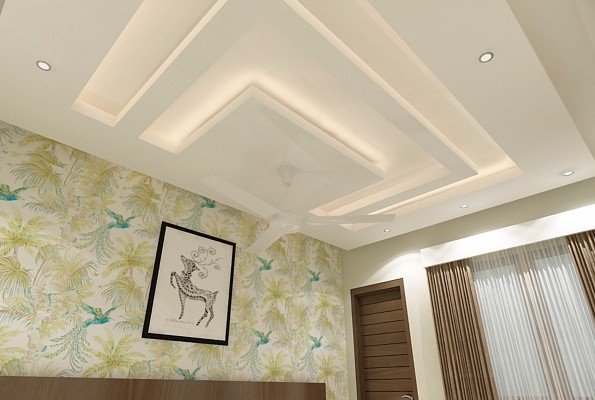A false ceiling, also known as a dropped ceiling or suspended ceiling, is a secondary ceiling installed below the main ceiling of a room. It serves both aesthetic and functional purposes, enhancing the interior design while also offering practical advantages like improved acoustics, better lighting control, and thermal insulation. This blog explores the types, benefits, and applications of false ceilings, making it easier to choose the right one for your space.
What is a False Ceiling?
A false ceiling is a lightweight structure suspended from the main ceiling using a framework of metal, wood, or gypsum boards. It can be designed to conceal wiring, plumbing, or ductwork while also enhancing the overall aesthetics of the space.
Types of False Ceilings
False ceilings come in various materials and designs, each offering distinct advantages:
Gypsum False Ceiling: These are known for their smooth finish, durability, and fire resistance. These ceilings are popular for residential and commercial spaces.
POP (Plaster of Paris) False Ceiling: POP ceilings provide flexibility in design, allowing intricate patterns and carvings while maintaining a smooth surface.
Wooden False Ceiling: Wooden ceilings add warmth and elegance to interiors, often used in hotels and luxurious spaces.
Metal False Ceilings: These are ideal for industrial and commercial settings due to their strength, ease of maintenance, and modern appeal.
Glass False Ceilings: These add a touch of sophistication and transparency to interiors, often used in offices and showrooms.
PVC False Ceiling: A cost-effective, moisture-resistant option suitable for bathrooms and kitchens.
Fabric or Synthetic False Ceilings: These offer creative design possibilities for theaters and auditoriums, enhancing acoustics.
Benefits of False Ceilings
False ceilings provide numerous advantages beyond aesthetic appeal.
Enhanced Aesthetics: They add depth and style to interiors, allowing for creative lighting arrangements.
Improved Acoustics: Helps in sound absorption, making them ideal for auditoriums, theaters, and offices.
Thermal Insulation: Reduces heat absorption, leading to better energy efficiency and lower cooling costs.
Concealed Wiring & Services: Hides electrical wiring, air conditioning ducts, and plumbing lines.
Customizable Designs: Offers flexibility in design with various materials and textures.
Fire Resistance: Certain materials like gypsum and metal are fire-resistant, improving safety.
Reduced Maintenance: Easier to clean and maintain compared to traditional ceilings.
Applications of False Ceilings
False ceilings are widely used in different settings, including:
Residential Homes: Enhances the living room, bedroom, and kitchen aesthetics while improving lighting and insulation.
Offices: Creates a professional environment with efficient lighting arrangements.
Hotels & Restaurants: Adds a luxurious touch while ensuring better acoustics and ambiance.
Shopping Malls & Showrooms: False ceilings provide decorative and functional benefits for commercial spaces.
Healthcare Facilities: Improves hygiene and temperature control in hospitals and clinics.
Educational Institutes: Helps in sound control, creating a conducive learning atmosphere.
Indian Standards for Ceilings
While there are no specific IS codes for all ceiling types, some related codes are:
IS 2544 – It covers ceiling boards.
IS 10322 – It covers lighting and electrical fittings for false ceilings.
IS 2835 – This is for safety in lighting fixtures.
National Building Code (NBC) – General guidelines on height and ceiling requirements
Final Thoughts
False ceilings offer multiple architectural feature that enhances the aesthetic and functionality of interiors. With various material options and designs, they offer customization according to personal preference and space requirements. Whether for residential, commercial, or industrial use, investing in a false ceiling is an effective way to transform a space while adding practical benefits.
Read Also-
Essential Plumbing Tools – Handy Guide
Download Also-
Building Planning and Drawing Textbook
Download National Building Code of India – Volume 1 & Volume 2
